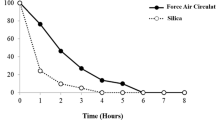Summary
The effects of desiccation rate on photosynthetic recovery of the resurrection plant Selaginella lepidophylla (Hook. and Grev.) Spring were examined. Gas exchange over a 24 h rehydration period, ribulose bisphosphate carboxylase conservation in desiccated fronds, de novo protein synthesis rate during rehydration, and frond leakage rate during rehydration were measured following desiccation at various rates. Seven-day hydrated, fully recovered plants were dried at four rates. The initial decline in tissue fresh weight/dry weight ratio was essentially linear to a ratio value of 1.35, the point at which frond curling occurred, but slowed thereafter. Frond curling required 5.5, 52, 94, and 175 h of desiccation, respectively, for the four treatments.
The rate of net photosynthesis after 24 h of rehydration was greatest for the two intermediate drying speeds; both very rapid and very slow drying were associated with significantly reduced rates. Electrolyte leakage was greatest following very rapid drying and de novo protein synthesis was impaired following very slow drying. Ribulose bisphosphate carboxylase conservation was not significantly affected by drying speed. These results support the hypothesis that desiccation injury is multicausal and that specific components of the photosynthetic recovery process respond differently to desiccation rate. However, in spite of these significant desiccation rate effects, overall photosynthetic recovery in S. lepidophylla appears to be relatively tolerant of widely varying rates of desiccation.
Similar content being viewed by others
References
Bergtrom G, Schaller M, Eickmeier WG (1982) Ultrastructural and biochemical bases of resurrection in the drought-tolerant vascular plant, Selaginella lepidophylla. J Ultrastruc Res 78:269–282
Bewley JD, Krochko JE (1982) Desiccation-tolerance. In: Lange OL, Nobel PS, Osmond CB, Ziegler H (eds), Encylopedia of Plant Physiology, V 12B, pp. 325–378
Brown DH, Buck GW (1979) Desiccation effects and cation distribution in bryophytes. New Phytol 82:115–125
Dhindsa RS, Bewley JD (1977) Water stress and protein synthesis. V. Protein synthesis, protein stability and membrane permeability in a drought-sensitive and a drought-tolerant moss. Plant Physiol 59:295–300
Eickmeier WG (1979) Photosynthetic recovery in the resurrection plant Selaginella lepidophylla after wetting. Oecologia 39:93–106
Eickmeier WG (1980) Photosynthetic recovery of resurrection spikemosses from different hydration regimes. Oecologia 46:380–385
Eickmeier WG (1982) Protein synthesis and photosynthetic recovery in the resurrection plant, Selaginella lepidophylla. Plant Physiol 69:135–138
Gaff DF (1980) Protoplasmic tolerance of extreme water stress. IN Turner NC, Kramer PJ (eds) Adaptation of plants to water and high temperature stress, Wiley NY, pp. 207–230
Gaff DF, Chuuchill DM (1976) Borya nitida Labill. — an Australian species in the Liliaceae with desiccation-tolerant leaves. Aust J Bot 24:209–224
Gwóźdź EA, Bewley JD, Tucker EB (1974) Studies on protein synthesis in Tortula ruralis: Polyribosome reformation following desiccation. J Exp Bot 25:599–608
Hambler DJ (1961) A poikilohydrous, poikilochlorophyllous angiosperm from Africa. Nature 191:1415–1416
Hinshiri HM, Proctor MCF (1971) The effect of desiccation on subsequent assimilation and respiration of the bryophytes Anomodon viticulosus and Porella platyphylla. New Phytol 70:527–538
Jensen RG, Bahr JT (1977) Ribulose 1,5-bisphosphate carboxylase-oxygenase. Ann Rev Plant Physiol 28:379–400
Roberts BE, Osborne DJ (1973) Protein synthesis and viability in rye grains. In: Heydecker W (ed) Seed ecology. Penn State Press, Univ Park, pp. 99–114
Ross E, Schatz G (1973) Assay of protein in the presence of high concentration of sulfhydryl compounds. Ana Biochem 54:304–306
Schonbeck MW, Bewley JD (1981) Responses of the moss Tortula ruralis to desiccation treatments. I. Effects of minimum water content and rates of dehydration and rehydration. Can J Bot 59:2698–2706
Sidell SG, Ellis RJ (1975) Protein synthesis in chloroplasts: characteristics and products of protein synthesis in vitro in etioplasts and developing chloroplasts from pea leaves. Biochem J 146:675–685
Simon EW (1974) Phospholipids and plant membrane permeability. New Phytol 73:377–420
Sokal RR, Rohlf FJ (1981) Biometry. Freeman, San Fran, p. 859
Tymms MJ, Gaff DF, Hallam ND (1982) Protein synthesis in the desiccation tolerant angiosperm Xerophyta villosa during dehydration. J Exp Bot 33:332–343
Villiers TA (1974) Seed aging: chromosome stability and extended viability of seeds stored fully imbibed. Plant Physiol 53:875–878
Author information
Authors and Affiliations
Rights and permissions
About this article
Cite this article
Eickmeier, W.G. Photosynthetic recovery of the resurrection plant Selaginella lepidophylla (Hook. and Grev.) Spring: effects of prior desiccation rate and mechanisms of desiccation damage. Oecologia 58, 115–120 (1983). https://doi.org/10.1007/BF00384550
Received:
Issue Date:
DOI: https://doi.org/10.1007/BF00384550




